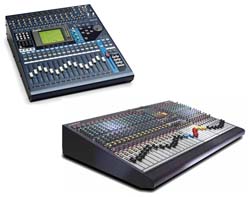
One more notable difference is the seemingly infinite patching capability of digital boards. With typical analog designs, for example, each channel strip has a dedicated input, which correlates to a dedicated input gain – everything in it’s place and a place for everything. Output routing is the same, a 1:1 ratio.
On the other hand, the physical inputs of the 01V96V2 can be re-assigned to different input channels. (However, note that this can lead to a visual disconnect between input gain and channel strip if one isn’t cautious.) Output routing can be equally flexible yet complex; a single output channel can be duplicated to every single available physical output if the user so desires.
For beginning sound operators, it’s often easier to learn an analog console, which more closely mirrors the basics of signal flow.
And again, there’s the physical aspect, with all controls intuitively accessible, easy to grab and set. This especially holds true for environments like churches, where volunteer help is common and the ability to walk in and mix with little training is key.
Yet whether it’s a matter of size, form factor, routing, onboard effects instantaneous recall, or some/all of the above, digital consoles have more than enough compelling features and advantages. Also note that there are a number of hybrid analog/digital options.
While price differences between the two formats is something each user should investigate, a general statement can be made that they’re fairly even when comparing “like” models in terms of channel counts, features and so on. (A big upside to digital is that significant upgrades such as a new software version can dramatically enhance the functionality of a current unit, and this is often provided free or at a low cost by the manufacturer.)
And as always, the standard rule of “you get what you pay for” applies. Which leads us to reliability. At the outset, digital was a bit lacking in this regard, but now, both formats are comparable, which is to say, both are very good. The bottom line: whether it’s analog or digital, it must be a quality product from a reputable manufacturer, or lack of reliability can be the unfortunate result.
I leave you with the words of long-time sound engineer Dave Natale: “I’ll sacrifice quality, flash factor and everything else for reliability.”
Kyle P. Snyder is an audio engineer with innumerable credits in the public and private sector, writing about audio engineering, recording technology, and a multitude of other tropics for ProSoundWeb.
